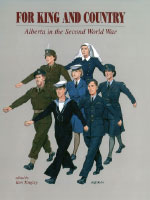Der Deutsche Kriegsgefangener auf Alberta*:
Alberta and the Keeping of German Prisoners of War, 1939-1947
*The German title is "German Prisoners of War in Alberta."
John Joseph Kelly
Reprinted with permission of the author and publisher of For King and Country: Alberta in the Second World War During the Second World War, some 38,050 German military personnel, merchant seamen and refugees experienced the hospitality of the Mackenzie King government, while they were being held in prisoner of war camps across Canada.1 I In a little-known aspect of Canadian history, the largest POW camps in this country were situated in Alberta, just outside the cities of Lethbridge and Medicine Hat. This is the story of how Alberta played a major role in the Canadian war effort by housing those German POWs whom Britain could not take because of her geographical proximity to the battlefields of Western Europe.
During the Second World War, some 38,050 German military personnel, merchant seamen and refugees experienced the hospitality of the Mackenzie King government, while they were being held in prisoner of war camps across Canada.1 I In a little-known aspect of Canadian history, the largest POW camps in this country were situated in Alberta, just outside the cities of Lethbridge and Medicine Hat. This is the story of how Alberta played a major role in the Canadian war effort by housing those German POWs whom Britain could not take because of her geographical proximity to the battlefields of Western Europe.
Throughout the spring of 1939, as the international political climate deteriorated with the German takeover of the remnants of Czechoslovakia, the Royal Canadian Mounted Police were working on a list of individuals in Canada who were to be arrested upon the outbreak of war, as well as those organizations, and their newspapers, which were to be outlawed. These included the following groups:
.... members of the German National Socialist Party (NS.D.A.P.), each of whom undertook to obey implicitly and without question the order of the Fuehrer and his representatives .... male members of the Deutsche Arbeitfront, which consisted of German nationals who described themselves as 'true followers of the Fuehrer.' Like members of the NS.D.A.P., they were recent immigrants to Canada, and were nearly all of military age, and thus under German law were liable for compulsory service in the German Army .... male German nationals resident in Canada, who were not known formally to be members of either the NS.D.A.P. or the Arbeitsfront, but who, from their political and social associations, business and industrial connections and other opportunities for espionage, were believed to be persons who could not safely be allowed at large in time of war .... and naturalized Canadian citizens of German birth or members of a racial organization, who identified themselves with Nazi propagandist activities so that they could not be regarded as loyal citizens of Canada. They were all persons of influence in their communities and were leaders of the Deutscher Bund, the Canadian Society for German Culture2
With the British declaration of war on 3 September 1939, the RCMP swung into action, and over the next six weeks they incarcerated some 358 individuals felt to be of questionable loyalty, predominantly from the metropolitan centres of Toronto, Montreal, Vancouver and Regina.3
There had been a historical precedent set during the First World War, when Canada had interned or placed on parole some 10,000 aliens, and had housed German combatant prisoners in Fort Henry, at Kingston, Ontario.4 However, upon the outbreak of war in September 1939, the Canadian government did not expect to be called upon to exercise a similar function. It believed that only about 400 civilians would need to be interned, and to handle this relatively small influx, only two camps were to be opened: one located on the site of the former relief camp at the forestry reserve near Petawawa, Ontario; and the other at the Kananaskis Forest Experiment Station, approximately fifty miles west of Calgary, and thirty miles east of Banff, near Seebe, Alberta.5 These sites were chosen because the government did not wish to spend too much money on what it felt was going to be a short-term, limited venture. This viewpoint was set forth in a letter from the Under Secretary of State, Mr. E.H. Coleman, to Mr. H.R.L. Henry, private secretary to Prime Minister Mackenzie King, in which he wrote:
.... the number of enemy aliens interned will not be large and it is earnestly desired that every possible economy should be exercised in setting up stations or camps .... [It] would be manifestly wasteful to set up this expensive organization in every section of the country ....6
It was felt at this time that accommodation for two hundred men at each site was sufficient, and that the internees could provide valuable work for the wartime economy at both these locations.7 The Kananaskis camp was the first to open, as a receiving station, with Major J.W. Stagg as the Commandant, and a guard of 29 men. By October 1939, there were 150 prisoners in the camp, with room for more if it was needed at a later time.
These first prisoners were not prisoners of war in the strictest sense of that phrase. Those who would be designated "Prisoners of War Class 1" were to have been captured in warlike operations, and were to be covered under Articles 1 and 81 of the Geneva Convention of 1929. The enemy aliens now resident in the camps would be referred to as "Prisoners of War Class II", and would not be entitled to the special rights and privileges accorded to combatant prisoners. They were to be subject to the same laws as the members of the Armed Forces of Canada. Prisoners were not to be employed on work having a direct connection with the war effort. For that work not directly related to the war effort which they could do, the pay rate for prisoners was fixed at twenty cents per day, a rate based on the cash allowance made to members of labour camps run by the Department of National Defence during the Depression in the 1930s. No access to newspapers was allowed, as it was felt that news of Allied defeats would hearten the internees. Representatives of the Protecting Power [the Swiss] were permitted to visit the prisoners. The most severe form of disciplinary action allowed for civilian internees would be confinement in the detention barracks for a period not exceeding 28 days. In November 1939, it was decided that the Canadian authorities would go as far as to allow the Geneva Convention to be applied to the civilian internees.8
For example, on 7 December 1939, two internees escaped from the Kananaskis camp, cutting their way through the wire, and remaining on the loose for five days. They were tried before a military court in Calgary and sentenced to two years imprisonment without hard labour.9 A similar escape in September 1940 netted another two-year sentence for each of the two prisoners.
Notes
1. Directorate of History, Department of National Defence, File 113.3P4 (D2), Directorate Narrative, 5 September, 1945.
2. National Archives of Canada, [NAC], W.L.M. King Papers, MG26, J1, Vol. 273, p. 231084, “International Security Measures Taken on the Outbreak of War”, 2 December, 1939.
3. NAC, Director of Internment Operations, RG6, L., Vol. 10, File 4-1-5 (1), Inspector D.C. Saul, RCMP to Director of Internment Operations, 20 October 1939.
4. NAC, Secretary of State Department, RG6, D1, Vol. 21, p. 1, W.D. Otter to the Minister of Justice [“Internment Operations 1914-1920”], 30 September 1920.
5. NAC, Director of Internment Operations, RG6, L, Vol. 11, File 4-3-1, General Panet to Lt. Col. Desrosiers, 11 September 1939.
6. NAC, W.L.M. King Papers, MG26, J1, Vol. 265, p. 225543, E.H. Coleman to H.R.L. Henry, 25 September 1939.
7. NAC, Director of Internment Operations, RG6, L, Vol. 11, File 4-3-1, General Panet to Lt. Col. Desrosiers, 23 November 1939.
8. NAC, Director of Internment Operations, RG6, L, Vol. 12, File 5-1-2, W. Stuart Edwards to General Panet, 17 November 1939.
9. NAC, Director of Internment Operations, RG6, L, Vol. 12, File 5-1-2, Lt.-Col. Hubert Stethem to the Department of External Affairs, 30 July 1940.
10. Lorne Bruce, “1940 German Prisoners Highly Satisfied with Alberta Internment Camp Life”, Nelson Daily News, 13 March 1940, p. 4.








